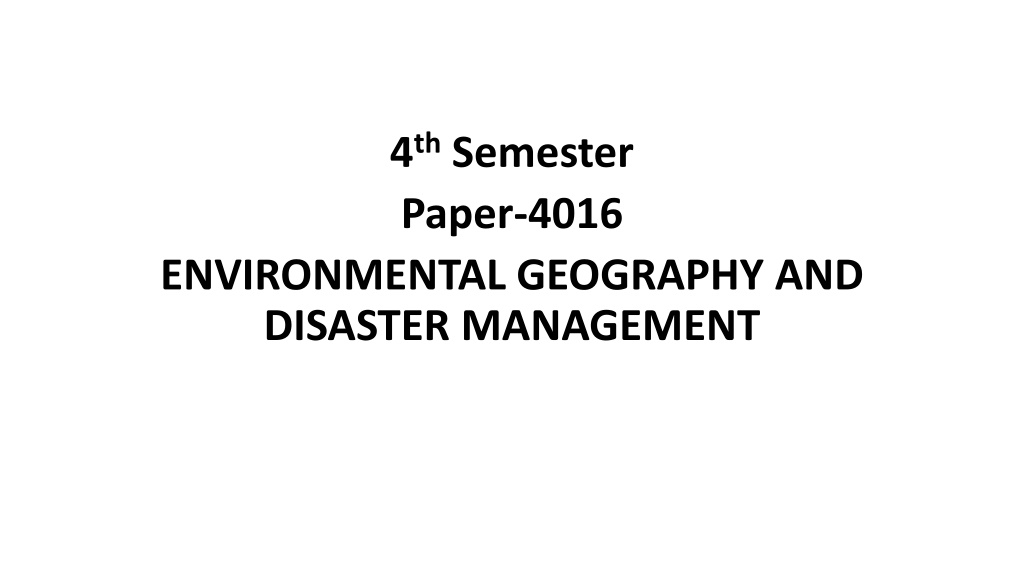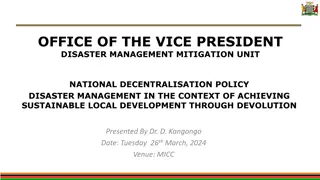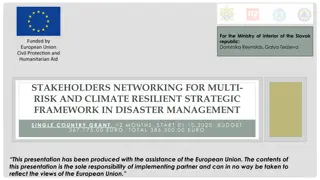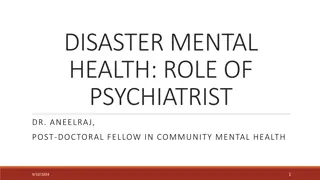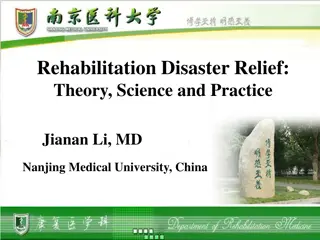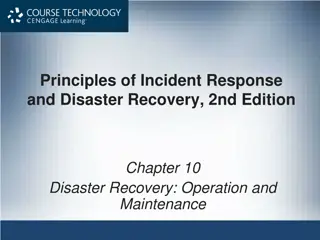Understanding Disaster Management Cycle and Phases
Disaster management encompasses planning, organizing, and implementing measures to prevent, reduce, and respond to disasters effectively. The disaster management cycle includes phases such as mitigation, preparedness, response, and recovery. The aim is to reduce potential losses, provide assistance to victims, and facilitate rapid recovery. Mitigation involves preventive measures, preparedness focuses on planning and training, response deals with immediate aftermath, and recovery involves long-term restoration efforts. Effective disaster management requires integration of emergency plans at all levels of government and community involvement.
- Disaster Management
- Mitigation Measures
- Preparedness Planning
- Response and Recovery
- Emergency Management
Download Presentation

Please find below an Image/Link to download the presentation.
The content on the website is provided AS IS for your information and personal use only. It may not be sold, licensed, or shared on other websites without obtaining consent from the author. Download presentation by click this link. If you encounter any issues during the download, it is possible that the publisher has removed the file from their server.
E N D
Presentation Transcript
4thSemester Paper-4016 ENVIRONMENTAL GEOGRAPHY AND DISASTER MANAGEMENT
DISASTER MANAGEMENT CYCLE AND PHASES Per the Disaster Management Act of 2005 defines Disaster Management as an integrated process of planning, organizing, coordinating and implementing measures which are necessary for- Prevention of threat of any disaster Reduction of risk of any disaster or its consequences Readiness to deal with any disaster Promptness in dealing with a disaster Assessing the severity of the effects of any disaster Rescue and relief Rehabilitation and Reconstruction The concept of Disaster Management Cycle integrates isolated attempts on the part of different actors,government and nongovernment, towards vulnerability reduction or disaster mitigation, within the enveloping domain of disaster management, as phases occurring in different time periods in disaster management continuum.This has facilitated a planned approach to disaster management in that post- disaster recovery and pre disaster mitigation planning are perceived as integrated/related activities.
Disaster management aims to reduce, or avoid, the potential losses from hazards, assure prompt and appropriate assistance to victims of disaster, and achieve rapid and effective recovery. The Disaster management cycle illustrates the ongoing process by which governments, businesses, and civil society plan for and reduce the impact of disasters, react during and immediately following a disaster, and take steps to recover after a disaster has occurred. Appropriate actions at all points in the cycle lead to greater preparedness, better warnings, reduced vulnerability or the prevention of disasters during the next iteration of the cycle. The complete disaster management cycle includes the shaping of public policies and plans that either modify the causes of disasters or mitigate their effects on people, property, and infrastructure.
Mitigation: Measures that prevent or reduce the impact of disasters. Preparedness: Planning, training, & educational activities for things that cant be mitigated. Response: The immediate aftermath of a disaster, when business is not as usual. Recovery: The long-term aftermath of a disaster, when restoration efforts are in addition to regular services. Management (or disaster management) is the discipline dealing of with and avoiding risks. It is a discipline that involves preparing, supporting, and rebuilding society when natural or human-made disasters occur. In general, any Emergency management is the continuous process by which all individuals, groups, and communities manage hazards in an effort to avoid or ameliorate the impact of disasters resulting from the hazards. Actions taken depend in part on perceptions of risk of those exposed. Effective emergency management relies on thorough integration of emergency plans at all levels of government and non-government involvement. Activities at each level (individual, group, community) affect the other levels.
It is common to place the responsibility for governmental emergency management with the institutions for civil defence or within the conventional structure of the emergency services. In the private sector, emergency management is sometimes referred to as business continuity management. Disaster Management efforts are geared towards disaster risk management. Disaster Risk Management implies the systematic process of using administrative decisions, organisation, operational skills, and capacities to implement policies, strategies and coping capacities of the society and communities to lessen the impact of natural hazards and related environmental and technological disasters. These comprise all forms all activities including structural and non- structural measures to avoid (prevention) or to limit (mitigation and preparedness) adverse effects to hazards . There are three key stages of activities in disaster management: 1. Before a disaster: to reduce the potential for human, material, or environmental losses caused by hazards and to ensure that these losses are minimised when disaster strikes
2. During a disaster: to ensure that the needs and provisions of victims are met to alleviate and minimise suffering 3. After a disaster: to achieve rapid and durable recovery Common perception of disaster management is limited to emergency relief and post- disaster rehabilitation.This is so because these 2 elements are by far and not separate. Thus, prevention, mitigation and preparedness form pre-disaster activities in the Disaster management Cycle and response, comprising relief, recovery and rehabilitation are post-disaster activities. Whilst emergency relief and rehabilitation are vital activities, successful disaster management planning must encompass the complete realm of activities and situations that occur before, during and after disasters. These phases can best be represented as a cycle, which if followed through public policy can obstruct future development of disasters by impeding the vicious cycle of cause and effect.
One of the key issues in disaster management planning is the allocation of resources at all stages of the disaster cycle, which optimises the total effectiveness of risk reduction activity and maximises the overall impact of disaster management. This approach has imparted a more holistic perception to disaster management and has served to integrate disaster management with development planning in that most predisaster activities, involve activities for vulnerability reduction like poverty reduction, employment provision etc. which are also mainstream development concerns. Thus, disaster management cycle implies development is essentially/conceptually related to disaster management.
disaster management cycle Source-Wikipedia
The different phases of disaster management are represented in the disaster cycle diagram. 1. The Disaster Event This refers to the real-time event of a hazard occurring and affecting the elements at risk . The duration of the event will depend on the type of threat, for example, ground shaking may only occur for a few seconds during an earthquake while flooding may take place over a longer period of time. Disasters have tremendous modifying impact on the physical landscape. Within a few minutes, an entire region is reduced to rubble in the event of an earthquake. The impact leads to loss of life and property in affected areas; losses being directly correlated to the vulnerability of the region, physical and socio-economic. Vulnerability is also socio-economic. Weaker sections of society, viz. women, children, aged and handicapped, mentally infirm, etc., suffer a lot more than their stronger counterparts. Studies have also unearthed positive correlation between poverty and vulnerability. .
The poor inhabit the most hazardous physical areas because they are easier to procure and offer added advantages, like proximity to sea for fishermen or fertile soil for farmers near flood prone areas etc., that makes them prone to losses, both of assets and life. The poor also lack the resilience to recover from shock in the aftermath of a disaster. This brings to light the need for multi-faceted response to disasters, which takes account of all social political and economic ramifications. Issues to be addressed range from physical to social and economic vulnerability of weaker sections that suffer more relative to other, better placed 2. Disaster Response A Disaster is a cataclysmic event that has severe modifying impact. Consequences are both physical and social/ human. Disaster Response has to tackle all aforesaid challenges. Disaster response entails restoring physical facilities, rehabilitation of affected populations, restoration of lost livelihoods and reconstruction efforts to restore the infrastructure lost or damaged.
There are inherent important lessons to be learnt from disaster response. Retrospectively, it brings to light flaws in efforts pertaining to policy and planning with respect to location and type of infrastructure and social schemes to improve the social positioning of the under privileged, particularly with respect to access to resources of the underprivileged. Disaster aftermath is evaluation time for the administrative set up in that disaster response exposes system weaknesses. Disaster is the ultimate test of administrative efficiency, in the sense of positive impact on the environment, preparedness, procedural simplicity, logistics, speed and expertise. There are inherent important lessons to be learnt with regard to administrative reforms by way of policy interventions to ensure: Better institutional preparedness
Countering contrary pulls such as lack of social cohesion owing to irrational differentiations that effectively impede response, in the sense of self- help and communitarianism. Long- term mitigation policy to counter vulnerabilities, structural and non- structural by enabling legal provisions and honest implementation of the same. 3. Recovery The recovery phase involves implementation of actions to promote sustainable redevelopment (reconstruction,rehabilitation) following a disaster. It covers long- term measures like, rebuilding of houses, assets, infrastructure, school building, hospital buildings, and other public buildings. It is a process undertaken by a disaster-affected community to fully restore itself to pre-disaster level. Recovery is the activity that returns infrastructure systems to minimum operating standards and guides long-term efforts designed to return life to normal or improved levels after a disaster. Recovery is also sometimes used to describe the activities that encompass the three overlapping phases of emergency relief, rehabilitation and reconstruction.
Emergency Relief Emergency relief refers to the period immediately following the disaster when steps are taken to meet the needs of survivors with regard to shelter, water, food and medical care. Activities undertaken during and immediately following a disaster, include, immediate relief, rescue, damage and needs assessment and debris clearance. Rescue and relief are critical elements of response. This would necessitate institutional/organisational improvements by way of better delegation to field agencies, improvements in decision-making and communication processes, incorporation of indigenous traditional knowledge on warning signs, a cartographic knowledge of safe and unsafe areas, survival methods, and traditional forms of insurance built around kinship and families. The most crucial aspect in relief and rescue is communication across involved agencies. Disaster zone is often equated with a war zone, where communication is the critical factor, often, crucial, in fact, the deciding factor between success and failure.
Rehabilitation Rehabilitation implies activities that are undertaken to support the victims return to of temporary housing and public utilities as interim measures to assist longer-term recovery through permanent housing and infrastructure.Besides physical elements, rehabilitation programmes also include economic rehabilitation through livelihood recovery and support actions and finding alternate employment options for those who cannot get back to their original occupations due to irreparable damage. Rehabilitation also includes psycho-social rehabilitation forthose who are badly traumatised and need support in terms of psychosocial counseling or even medication in some cases. Reconstruction Reconstruction attempts to return communities to improved pre-disaster functioning.
It includes the replacement of buildings, infrastructure and lifeline facilities such as roads, bridges and communication links, so that longterm development prospects are enhanced rather than reproducing the same conditions which made an area or a population vulnerable in the first place. 4. Development The inclusion of development as a phase in the disaster cycle is intended to ensure the natural disaster,societies factor hazard and vulnerability considerations into their development policies and plans in the interest of overall progress. The rationale behind the use of the expression disaster management cycle is that disaster and its management is a continuum of inter-linked activities. It is sometimes also referred to as the disaster-development cycle , implying that disasters are periodic phenomena and occur regularly in such a way that there is development, followed by a disaster, then back to development till the next disaster
